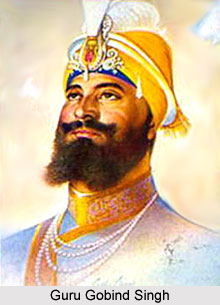 Guru Gobind Singh, the tenth Guru fought many battles with the Mughal Empire. Jujhar Singh, a Rajput prince was sent to conquer the Guru. The representative of the governor of Lahore, Rustam Khan assisted him. Guru Gobind Singh sent Gaj Singh of Jaswal with an army who laid an ambush at Bhalan village and defeated the enemy with heavy casualties. Thus, the enemy failed to reach Anandpur Sahib. The Guru gathered his disciples in huge number and sent them to Anandpur. The Guru for some time engaged in providing suitable training to the large influx of Sikhs. He also taught them disciplines and made them observe a proper code of conduct. The increased strength of the Sikh forces under the Guru alarmed the Kangra faujdar as well as some rajas. They now went to Aurangzeb`s and sought his advice and help to curb the rising Sikh power. In November 1693, Aurangzeb directed the faujdar to prevent the Guru from assembling his Sikhs. A large expedition was sent under Hussain Khan. The Guru also sent a strong force to help the hill rajas. In the ensuing battle Hussain Khan and some hill rajas were killed. The Guru instructed the hill rajas not to pay tribute to the Mughals. The Mughal force sent small forces against in the Gurus in the year 1694, 1696, and 1697. However, all their efforts were in vain as the guru could not be defeated.
Guru Gobind Singh, the tenth Guru fought many battles with the Mughal Empire. Jujhar Singh, a Rajput prince was sent to conquer the Guru. The representative of the governor of Lahore, Rustam Khan assisted him. Guru Gobind Singh sent Gaj Singh of Jaswal with an army who laid an ambush at Bhalan village and defeated the enemy with heavy casualties. Thus, the enemy failed to reach Anandpur Sahib. The Guru gathered his disciples in huge number and sent them to Anandpur. The Guru for some time engaged in providing suitable training to the large influx of Sikhs. He also taught them disciplines and made them observe a proper code of conduct. The increased strength of the Sikh forces under the Guru alarmed the Kangra faujdar as well as some rajas. They now went to Aurangzeb`s and sought his advice and help to curb the rising Sikh power. In November 1693, Aurangzeb directed the faujdar to prevent the Guru from assembling his Sikhs. A large expedition was sent under Hussain Khan. The Guru also sent a strong force to help the hill rajas. In the ensuing battle Hussain Khan and some hill rajas were killed. The Guru instructed the hill rajas not to pay tribute to the Mughals. The Mughal force sent small forces against in the Gurus in the year 1694, 1696, and 1697. However, all their efforts were in vain as the guru could not be defeated.
Aurangzeb sent Prince Mauzzam or Bahadur Shah I to the north to subdue the hill rajas and the Guru. Actually Mauzzam reached Lahore in August 1696 on his way to Kabul and sent some forces to collect tributes from the hill rajas. The entire force of Mughal wrath fell on the rajas and the Guru`s headquarters were left unharmed. The arrival of Mauzzam had been a cause of great anxiety to the Guru, and his departure now gave him much relief.
This article is a stub. You can enrich by adding more information to it. Send your Write Up to content@indianetzone.com




















